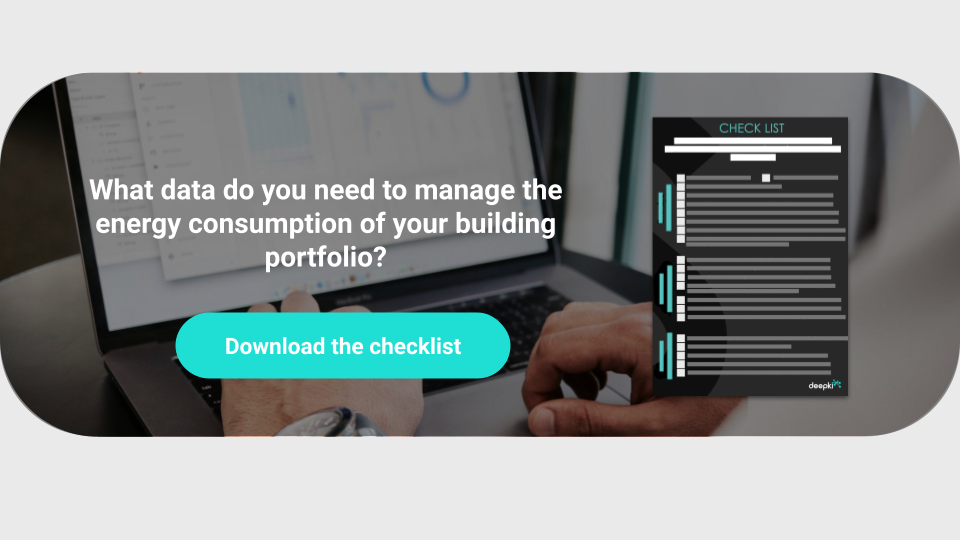Whatever your purpose – whether it’s regulatory compliance, CSR reporting or certification – data collection is key to managing your real estate assets. This process concerns all sorts of information including asset data, energy consumption, activity, ESG criteria and open data. But collection is no simple task! Large property portfolios involve numerous stakeholders, and widely dispersed data that’s difficult to centralize.
We’ve put together some advice here, including a list of key questions to cover before embarking on any data collection endeavor. Say goodbye to the endless information chase, and hello to pragmatic data collection!
Available data
There are five main categories of data:
- Asset data like a building’s address and surface area
- Activity data, including the building’s function and opening hours
- Energy and utilities data – electricity, gas and water consumption, etc.
- ESG (Environmental, Social and Governance) data, like gender representation and respect for employees’ rights
- Open data such as weather and climate risks
Data collection challenges
Data collection can be complicated, with multiple challenges along the way:
- Taking inventory of all the information needed to meet your objectives
- Reaching out (and sending reminders) to contacts inside and outside the company
- Checking data accuracy, once collection has begun
- Dealing with time constraints, perhaps the biggest obstacle
So how can these obstacles be overcome?
Pragmatic data collection: automatic vs. manual
There are two methods of data collection: automatic and manual.
The automation of data flows requires a fairly complex configuration. For gathering large amounts of data or doing regular updates, this method can be very advantageous – saving time, providing more reliable data, allowing for real-time updates, etc.
But setting up automatic collection isn’t always necessary or even justified, especially in cases where the cost outweighs the benefits. Manual collection could be more appropriate for a small real estate portfolio, for example, where there is less data to enter and infrequent updates.
How does manual data collection work?
When automatic data collection is prohibitively expensive or demanding, manual collection is the best option. This method is adapted to all types of data, both qualitative and quantitative. But because manual collection is subject to human error, it’s vital to check your data for anomalies. Make sure that information is entered in the proper format, for example: numbers for consumption data, letters for addresses and correct orders of magnitude. If a stakeholder reports quarterly waste of 1.5-2 tons but then indicates 17 tons for one quarter, you can assume there’s a missing a decimal point and request confirmation.
6 key questions before delving into data collection
1. What are your goals?
Your answer to this question will help determine what information needs to be gathered. Since collection requires a considerable effort, it’s important to stay focused on the data that’s pertinent to your objectives.
2. Where can this information be found?
Once you’ve established what data you need, the next step is determining where to get it. This means finding out where the data is stored and the easiest way to retrieve it. For example, invoices can be sourced from:
- The accounting department
- Energy suppliers
- Energy distributors
- Meters and/or sub-meters
- Tenants (in the case of private data)
3. Am I allowed to collect this information?
Some data is confidential, meaning access requires permission from the person who owns it. Ex: in the case of consumption data for private areas, you’ll need a signed letter of authorization from each tenant authorizing you to collect the data.
4. What is the best collection method?
It’s important to choose the method most suited to your available data, but also to your needs. For example, designing an API (application programming interface) requires a significant investment of time and money, so isn’t always the best option. For data that only requires annual updates, it could be better to maintain manual data entry or set up an FTP (File Transfer Protocol).
5. Is my data complete?
To get a global view of your portfolio and allow for in-depth analysis, make sure you’re in possession of all the necessary data (ex: one monthly invoice for each building). Incomplete data impairs your analysis capabilities and hinders the decision-making process.
Good to know
When information is missing, data repopulation (based on estimates) can be used to fill in the gaps and ensure informed decisions.
6. How reliable is my data?
Whether you’re relying on manual or automatic collection methods, data must constantly be verified. To speed things up, data quality can be checked using algorithms for automatic anomaly detection.
The bottom line: your data is a goldmine, but collecting it can be a colossal, complex task. Check out Deepki’s pragmatic approach by downloading our checklist data collection:



